Photos by Kip Miller
"We're heading out to Sifnos tomorrow," I remind our hosts over coffee in their Kalymnos kitchen. "Our long-time friends, Mary Vouras and Bill Doebele, have invited us to stay with them in Exámbela," I elaborate. "Amazingly, their house was once owned by Nikolaos Tselementes." "Aha," says Madelyn, with a nod of recognition. "Isn't he the great chef who is considered the father of Greek cuisine?" "Yes," I smile. "His name is a synonym for cookbook." Madelyn heads straight to a bookshelf and pulls out her own copy of "Tselementes." "See, every Greek household has one!" she announces with pride.
Our time
in Kalymnos has been a revelation. This wildest of the Dodecanese islands
is surrounded by crystal-clear seas worked by generations of sponge divers.
Our hotel in Kantóuni is just steps from Madelyn and Niki's house
and we have explored the highlights of the island together. We've lazed
on beaches at Myrtiés and Embório and crossed over to the
tranquil islet of Télendos. We've wandered through most of Póthia,
the capital, from its bustling harbor and folk museum to the Vouvális
Mansion brimming with archaeological treasures. Just yesterday we journeyed
to the inlet at Vathýs, the dramatic fjord of Kalymnos where we
feasted on mermizéli, a tangy salad served with barley rusks, once
the sustenance of sponge divers on their long journeys, followed by stuffed
kalamária, grilled octopus and pastries dripping with local thyme
honey. At breakfast just yesterday we sampled Kalymnian eftázymo,
an exquisite round bread flavored with mastic and ouzo and kneaded seven
times--the showpiece of Póthia's waterfront bakery. Can it get
better than this? Apparently so, because the best food in Greece awaits
us in Sifnos.
 Sifnos
was renowned in antiquity for its rich gold mines. Today its port, Kamáres,
is
Sifnos
was renowned in antiquity for its rich gold mines. Today its port, Kamáres,
is
famed throughout the Aegean for spotlessly clean beaches and skilled potters.
I first heard about Sifnos decades earlier upon arrival at Delphi. The
Sifnian Treasury is one of Delphi's prize remains, a testimony to the
fabulous wealth of the island which donated a solid gold egg to the Oracle
every year. Our guide evoked images of an island laden with silver and
gold mines, whose inhabitants were fine craftsmen and potters. Naturally,
the gods favored the generous Sifnians, she divulged, until one year their
annual gift was reduced to a gilded egg, greed having overtaken them.
Apollo became enraged and caused the mines to sink into the sea, denouncing
the Sifnians as "worthless and unclean," destroying their reputation
forever after. "Maybe that explains why today Sifnos is ranked as
the cleanest island in the entire Aegean," I suggest to my husband
as we board the Blue Star ferry the following morning. "They have
to prove the gods were wrong!"
It's a calm day on the Aegean. The sea is silky smooth, barely a white cap in sight. A luminous blue sky stretches as far as the eye can see. Islets and rocky outcrops rise here and there, each seeming larger than life in the brilliant light. It's a ten-hour journey to Piraeus and I take advantage of the time by reading up on the island's history. After the collapse of its wealth, Sifnos emptied out, its very name denoting "emptiness." It fell under a succession of conquerors, from Romans, Venetians and Spaniards to Turks and centuries of pirates. The islanders built their villages inland, far away from marauding corsairs, neatly terracing their hills to cultivate some 60,000 olive trees, almonds and figs. Where trees grew best water nymphs were revered, their legacy lingering to this day.
Lacking an airport, Sifnos keeps mass tourism at bay, remaining a favorite escape for a select following of Europeans and Athenians, especially artists and intellectuals who return each summer. It is the greenest island in the entire Cyclades and its harbor, Kamares, the cleanest in the Aegean. Dovecotes dot the Sifnian hills, each one a miniature castle where doves are fattened for the cooking pot. Windmills, some in ruins, rise on ridges and remnants of a network of Venetian and Roman watchtowers still guard the coastline. As in many Greek islands, white-washed chapels are omnipresent, not to mention historic churches laden with treasures. Apparently, the island is bathed in a diffused light that softens the contours of the land. "Sounds heavenly. I can't wait!" I tell my husband.
We take a long afternoon nap, awakening just as our ferry begins the approach to Piraeus. Early evening is a busy time and throngs of passengers are clustered at our dock. The ferry for Sifnos is not scheduled to leave until the next morning, so we take a room at a comfortable hotel within walking distance to the port. Early in the morning, we make our way to the designated dock for Sifnos, only to find out that the ferry had just left. Frustrated, we query the ticket seller who refuses to look up from her newspaper. "The next boat leaves at three o'clock," she finally reveals, coffee cup in one hand, cigarette in the other. "What do you mean three o'clock!" says my exasperated husband. She has no more information. We stop at the ticket office of the line next door. They have a ferry leaving for Sifnos in half an hour! "Obviously, synergasía (cooperation) is a meaningless word in the Greek vocabulary," I grumble to myself.
We glide
alongside the Attica Peninsula as a little headwind ripples the sea. Leaving
Athens's urban sprawl behind, the glistening waters of the Saronic Gulf
resemble a giant mirror. At the southern tip of Attica, I glance up at
Poseidon's temple at Sounion, imagining how reassuring this site must
have been to generations of seafarers returning home after long journeys.
The ferry turns toward the western Cycladic chain, stopping first at Kithnos,
then at Serifos. The latter appears dry and dusty, its capital ascending
barren hills above the harbor. The approach to Sifnos is long and slow.
Tall cliffs on the western side of the island shield the bay of Kamares,
a sleepy port crowded with small hotels, tavernas and pottery shops. The
water is transparent, the sand pristine and swimmers are frolicking noisily
in the afternoon sun.
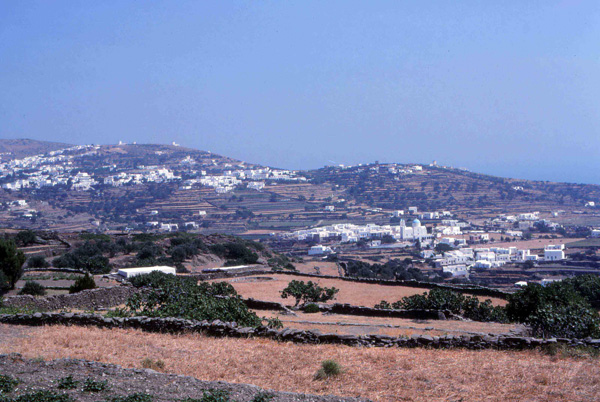
Unlike the other Cyclades, Sifnos is bathed in a diffused light that softens its contours. In the interior,
interconnecting whitewashed villages crown terraced hills crisscrossed by footpaths.
Sifnos's towns are clustered in the central foothills, so we grab a taxi. "You will love our island," says the driver, happy to practice his English. "Where you go?" he asks. "Exámbela," I respond. "Ach, Exámbela, polí nóstimo méros (a charming place)," he sighs. We wind through Apollonia and Artemónas, the island's largest towns, so named for Apollo and Artemis who were venerated by the Sifnians in antiquity, continuing past Káto Petáli. Even from afar, Sifnos is picture perfect: Iconic sugar cube houses gleam with fresh white wash and blue shutters, crimson bougainvillea drapes stone walls, and tiny squares abut centuries-old churches. "It will be fun to explore this place," I smile at my husband. The taxi comes to an abrupt stop in front of a sign for Exámbela. "Ftásame (we've arrived)," the driver announces. We wind our way into the village, asking for Mary's house. "To spíti tis eínai páno kai píso (her house is up and back)," a lady in black tells us. Two palm trees are supposed to mark the house. I spot it ahead, with Mary out in front, buying vegetables from a peddler who has come calling with his mule.
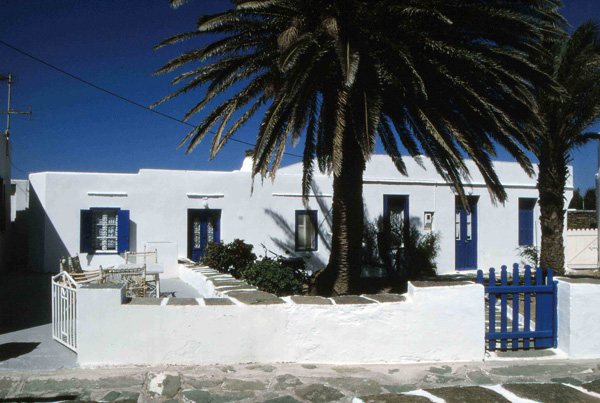
In Exámbela, Mary and Bill's house was once the summer home of Greece's renowned chef, Nikolaos Tselementes.
We unpack in the outside guest suite. Our friend Elinor has already arrived
and has taken the bed in the living room. All five of us have all been
traveling together for years and are thrilled to be reunited. Bill gives
us a quick tour of the house and then brings out some ouzo, olives, and
tangy manóura cheese to nibble. "I am sure you're aware that
Tselementes was born in Sifnos," he mentions. "This was his
summer house, remodeled after he became an established chef in Athens."
Bill elaborates, relating how Tselementes ultimately sold the house to
McNeil Lowry, the vice president of the Ford Foundation whom Mary knew
well and that she purchased it from Lowry after he left Greece. "It's
a comfortable place and this week we just got a direct line for water,"
he adds. "We won't have to rely on the cistern anymore." Bill
shows us the kitchen with its charming tiled burner. "I hope we can
try it out one night, I tell Bill.
We wander out to the alóni (threshing floor) at the edge of the property to enjoy the view. The sun is sinking rapidly, streaking the surrounding hills in fiery orange. A donkey brays noisily at a nearby farm and cooking scents drift up from a neighbor's house, awakening our appetites. "Let's just eat nearby tonight," Mary suggests, having twisted her ankle a few days earlier and unable to walk very far. It's a two-minute stroll to Exambela's sole restaurant, To Stéki. Mary waves to Antonis, the owner, who leads us to a table by the front window. "You realize, of course, that all the best chefs in Greece come from Sifnos," she comments as we peruse the menu. "Most of them trained as ship's cooks and later worked in the finest restaurants in Athens. Here in Sifnos everyone takes cooking seriously." With that introduction, we dive into Steki's specialties: revithókeftedes (similar to falafel), the local caper salad, and cuttlefish stuffed with onions. It is Greek food unlike any we've had before, bursting with fresh herbs and new flavors. "Why have we waited so long to come here?" asks my husband.
The next
morning Elinor accompanies us on the bus to Apollonia. This slow-paced
town is meant for leisurely exploration, with a narrow pedestrian walkway
that links the adjoining communities of Artemónas, Ano Petáli
and Káto Petáli. We begin at Plateía Iróon,
the central square that fronts the Sifnos Folk Museum famed for displays
of local costumes and weapons from the 1821 War of Independence. Even
this early in the day, laid-back tourists and locals are already crowding
bars and kafeneía, chattering over their newspapers and frappes.
Bakeries exude aromas of just-baked bread and milópites-- Sifnian
cheese pastries flavored with bergamot. Restaurants are cooking for the
mid-day meal, and eclectic boutiques display summer clothing and ceramics.
I stop in front of a tiny jewelry shop, its window filled with gold creations
based on ancient designs. Several pieces are so exquisite that I wander
in, anxious to examine a ring that could have been made during Sifnos's
heyday. It is 22-karat gold, extra yellow, with a timeless quality. "I
promise to treasure it," I vow to my husband as we walk out with
our new purchase. "It will replace the engagement ring that got ruined
in our disposal years earlier," I rationalize, delighted to have
a unique piece from this island of lost gold mines.
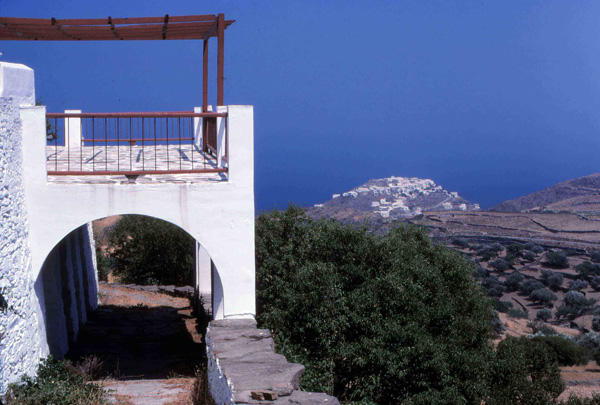
The view from Artemónas extends all the way down to Kastro, the island's ancient stronghold and capital until 1836.
A little higher up, Artemonas is distinguished by elegant neoclassic mansions,
historic churches and a row of windmills, some still in working condition.
From here the vistas of the island are breathtaking in all directions.
Hillsides rise steeply from the Aegean, dotted with gleaming white villages
and crisscrossed by centuries-old foot paths edged with dry stone walls.
We can see all the way down to Kastro, the oldest settlement in Sifnos.
As we stroll, the wind kicks up, and tall oleanders and bougainvillea
bushes sway in the breeze, their colors so vibrant against white stone
walls that they almost glow. We stop at a popular zaharoplasteíon
(sweet shop) to purchase a little gift for Bill and Mary. Theodorou's
is an institution in Artemónas, owned by a family that arrived
in Sifnos from Constantinople after the 1923 catastrophe. Second-generation
owners Nikos and Katina have blended their own Anatolian recipes with
traditional island sweets. "Párte mia yéfsi" (take
a taste), Katerina smiles as she hands us one of her almond honey creations
(amygdálota), followed by Theodorou's version of pastéli,
a sesame confection. I notice that the sales counter is part of their
living room and ask about the wonderful old mural of Constantinople painted
on the back wall. "Na min xehnáme tin póli mas (so
that we don't forget our city)," she says with a wistful smile.
By now it's time for lunch and the family-run Artemónas hotel is on our recommended list. Chef Stamatis Lembessis is known for delicious fare based on ingredients from his family's organic farm. We mop up every morsel of our veal and green bean stew with chucks of crusty bread. I survey the garden dining room accented with pots of basil and thyme. All the other patrons are licking their plates clean too. We break out in a big smile. It is always a joy to watch Greeks eat with their customary gusto! "Personally, I will never get tired of Greek food," I tell Elinor as we pay the bill and wave to Stamatis.
Pottery is
the traditional occupation of Sifnos. The island has a rich lode of clay
that has been worked for millennia. We take the bus down to Kamares where
several potters sell their wares. Perhaps the most renowned is the shop
of George Atsonios, a prize-winning potter who also operates in Maróussi
outside of Athens. Named Peristerióna after the dovecotes of Sifnos,
it is a charming emporium hung with distinctive pieces made of red clay
and covered with clay slips. The decorations are all based on local folk
traditions such as birds, flowers, mermaids and even the Byzantine two-headed
eagle. George is on the premises today and is delighted to show us around.
"My family does all the decorations," he says as he points to
Simos and Maria. "We use a transparent glaze and we fire each piece
twice in a furnace that exceeds 1000 degrees. If you have time, you should
also see the work of Kostas Depastas in Heronissos," he suggests.
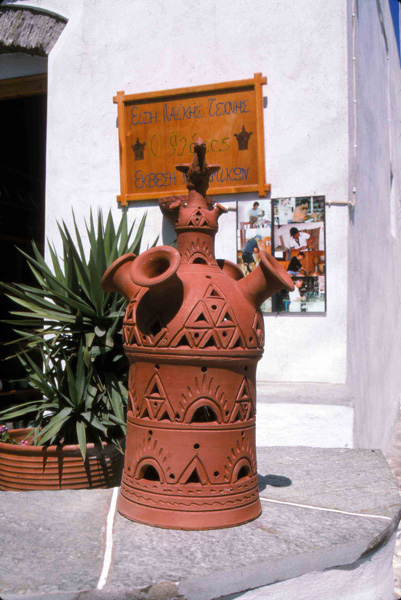
Today's fláros, the island's beloved chimney pot, is purely decorative. But in days past,
a fláros channeled smoke from wood-burning kitchens and deflected winter rains.
Heading back to Apollonia, we stop at "Fláros," a unique
shop that makes the island's iconic chimney pots. These inverted clay
creations have several spouts and are placed over an opening in a roof
to channel smoke from burning wood in a kitchen. They also protect the
house from seasonal rains that can pour through an ordinary chimney. But
that was in the past. Today a fláros is merely a decorative fixture
on island homes, no longer acting as a chimney. "It is also part
of our language," says the shopkeeper as we select a beautiful specimen
to ship home. "We say 'Ton kakó sou ton fláro'' (your
bad fláros). It means that you are very indignant that a wrong
conclusion was reached," he adds as we pause to take a photo.
Mary is holding court with several neighbors in her front yard when we return from our escapade. She introduces us all around and I pass out some of Theodorou's amygdálota. "Yia sta héria sas (bless your hands)", says a rotund lady, her shrill voice loud enough to be heard as far as the Exámbela bus stop." Mary has elevated her ankle and is not in the mood to venture out today. "How about if we cook at home," Elinor suggests. We all had been secretly hoping that we could actually cook in Tselementes's kitchen and I snoop around looking for all the necessary utensils. Alas, it is minimally stocked. "Forget moussaká, let's just make spaghetti and a large Greek salad," suggests Elinor. We wind down a narrow lane, dodging donkeys and scooters, and head to the nearest market. A couple of hours later, seated on the rear terrace, with burnished hills and the glittering sea in the distance, we relish our own cooking. "Everything tastes better here," says Bill, "don't you think?" Garden fresh produce is surely a big part of it, but I'm convinced that the secret ingredient is Tselementes.
Early the next morning we pile into Bill's car and drive to the barren north end of the island. Herónissos is the sole village here, almost cut off from the rest of Sifnos and often battered by howling winds. In years past it was reachable only by boat or footpath, but a recently paved road is bringing a smidgen of tourism here. The outpost sits at the end of a long, narrow inlet that almost resembles a river. There is a smattering of sugar cube houses and tiny shops, two tavernas and a potter's studio. The sea is quite shallow here and a few colorful caïques bob on water so clear that they appear to be suspended in midair. I gaze in amazement at a seabed encrusted with barnacles, spiny sea urchins and colorful pebbles. A school of striped grey fish is swimming in formation, trailed by swirls of smaller red fish. As you would expect, Herónissos is renowned for its superb seafood. So we plan ahead, ordering a red mullet for lunch that will be plucked from the water, scaled and grilled to order, giving us a little time to check out the local wares.
Kostas Depastas is one of a shrinking coterie of old-time potters. He greets us with a friendly smile, grabbing a lump of clay, but not willing to reveal where he digs it up. Wetting his gnarled hands, he sits behind his potter's wheel which begins to spin. Soon the pot begins to take shape and he uses his thumbs to form the lip of the pot. He is making a mastélo, the island's signature pot used to cook lamb for the Easter feast. He shows us a skepastaría, a deep covered pot that is used in making revitháda, a delicious chick pea soup that is the traditional mid-day meal on Sundays. "Cooking in clay pots," Depastas explains, "allows the food to absorb the flavors of the land." Following in the footsteps of generations of potters, he prefers to use a wood-fired kiln. A dusty sales room is packed with stacks of cooking vessels, cups, plates and some "trick" wine carafes that Depastas makes to amuse himself. Without any hesitation, I select a few pieces for our ever-growing collection of Greek ceramics.
Late that
afternoon we head to Platís Gialós, the island's finest
beach with a long arc of sand and a several popular tavernas and bars.
The sea is refreshing, a glorious way to end the day, and a large karpóuzi
(watermelon) is all we crave after the swim. "How is it that a Greek
watermelon is always ripened to perfection, so wonderfully sweet yet never
mushy?" I ask my husband. We set out on a slow walk back to Exámbela
as the sun begins to sink. The scent of thyme perfumes the evening air
and goat bells tinkle in the distance. A local farmer has just lit a votive
candle in a kandylakió, a tiny roadside shrine to commemorate a
loved one lost in an accident. He waves at us with a hesitant smile as
we walk past. An old griá (widow in black) on a mule loaded with
brushwood is rushing to get home before it gets dark. Not to worry, I
think. An abundance of stars and a bright moon will light her way.
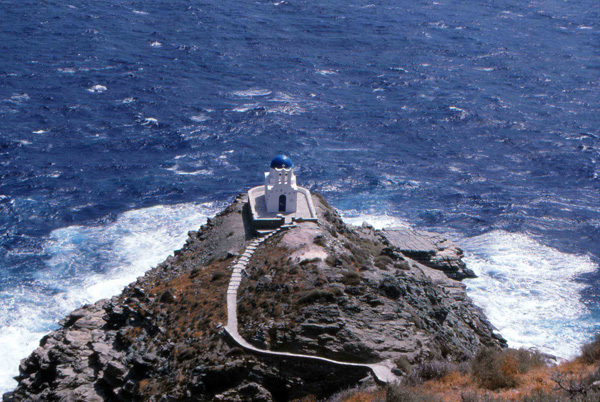
Crowning a craggy headland below Kastro, the tiny Church of the Seven Martyrs is Sifnos's most photographed site.
Mary is still indisposed on our third morning, so we leave her behind and journey down to Kastro, a fortified town astride a rocky cliff and the island's capital until 1836. Kastro has ancient roots and columns and capitals from its Cycladic and classical periods are incorporated into houses from the Venetian era. It was then that the town reached its zenith. Kastro's nobles, part of the DaCoruna family that controlled the island, lived in mansions in the protected inner ring of the city, while peasants lived in the outer ring that was more vulnerable to pirate attacks. The town retains its atmospheric medieval air with tunnel-like entrances, hundreds of steps, and precipitous, narrow lanes barely wide enough for a donkey to pass. We climb up to the archaeological museum and then head down to a little bar, Remezzo, for a frappé. New Age music is blaring. I sit back and gaze contentedly at the cobalt sea beyond. The solitary Church of the Seven Martyrs crowns a craggy headland below, surely the most photographed spot on the island. "Let's wander down to the beach at Seralia," suggests Bill. "We can grab some lunch there." We descend a narrow path sandwiched between crumbling retaining walls, its crevices brightened with caper blossoms. Ahead of us a tiny taverna commands its own pebbly beach. Half a dozen tourists are sunbathing or gingerly wading in rocky shallows. The menu is short, but the offerings unique: tangy shrimp balls, a rustic pie with filled with tender octopus redolent with ouzo, a hearty fish soup accompanied by toothsome bread. We lap it all up with a round of Mythos beers. A seafarer's feast befitting the setting!

The hidden cove of Seralia is an idyllic spot for sunbathing and fresh fare from the sea.
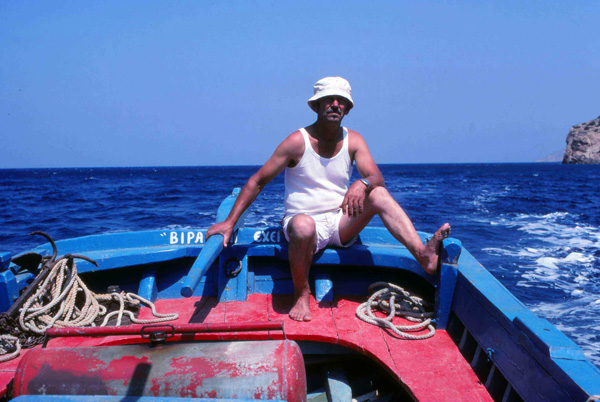
Fisherman Kostas commands his sea-worthy caïque on a leisurely exploration of Sifnos's southern coastline.
"You can't leave Sifnos without a sea excursion," says Mary on our final morning. "We know a wonderful fisherman who will take us around the southern side of the island by boat." And so we head to Kamáres where Kostas awaits us in his red and blue caïque. As he pulls out, I marvel anew at the clarity of the water and the cleanliness of the harbor beach. "Sifnos sets the bar very high," I comment to Mary. "I know," she says. "There is no other island like ours." Kostas hugs the coastline, taking us past the sleepy fishing village of Fáros, and then alongside a small peninsula crowned with the gleaming white church of Chryssopigí. It was here that an icon of the Virgin Mary reputedly achieved a great miracle. According to legend, two girls were fleeing pirates who were about to molest them and ran to the church for safety. They prayed for succor in front of the icon, and in no time the hill in front of the church split, creating a nine-foot chasm, making it impossible for the pirates to go any further. Today Chryssopigí has become the symbol of Sifnos. A breathtaking spot, it is also the island's premier wedding site. Kostas continues to an isolated inlet and moors the boat. We climb out and hike up a small hill dense with sage and thyme, finding some smooth rocks for sunbathing. Mary rests her ankle, taking in the scenery around her. "Ach, ti oráia (how lovely)," she sighs.
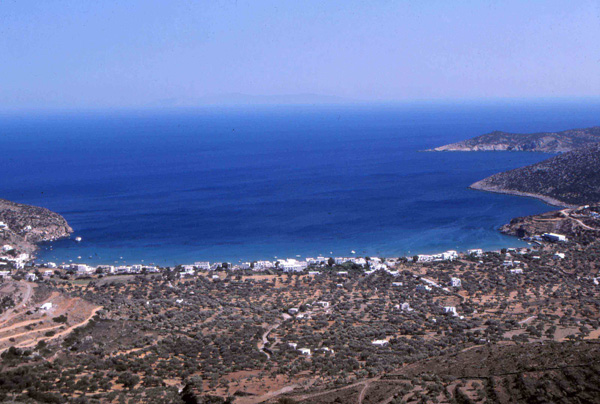
Vathí is a quiet family beach known for pottery workshops and traditional food.
We return to Kamáres invigorated by the sea and ready for a celebratory meal. Bill heads down a newly paved road to Vathí, a small beach community renowned for traditional cooking. To Tsikáli Restaurant has been run by Nikos and Flora Frantzeskaros for more than 30 years. Much of their cooking takes place in a communal wood-fired oven behind the restaurant and nearly all of their ingredients come from their own farm just up the hill. "Both revitháda and lamb mastélo are on the menu," they tell us. Nikos, who studied culinary arts in Athens, shows us the oven where an earthenware pot has been baking for hours. The aroma is indescribable, stoking our appetites. He brings out a plate of his own manóura cheese, made from sheep and goat milk, coated in crushed sea salt and the sediment from wine barrels. Nikos's chickpea fritters are perfectly seasoned and his spanakopita is enveloped in home-made phyllo. We dive into the revitháda. It is a magical soup, having absorbed nuanced flavors from the different woods used in the oven. But the meal's crowning glory is the mastélo: delectable lamb unlike any I have ever tasted, meltingly tender, refreshed by dill and enriched by red wine, vine branches and smoke.
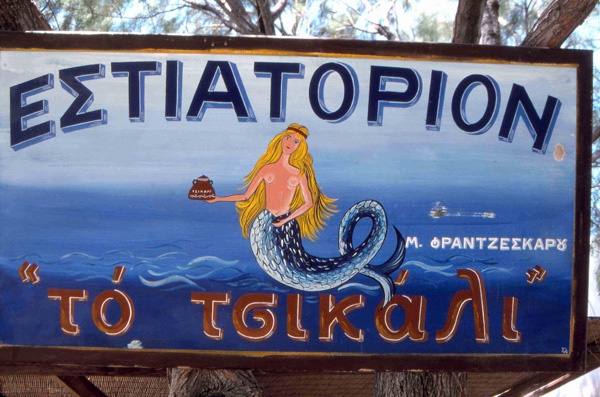
The Frantzeskaros family, admittedly inspired by Tselementes, are masters of island specialties.
At their popular restaurant, To Tsikáli, a communal wood-burning oven located right on the
beach imparts rich, nuanced flavors to simple fare.
"Has Tselementes influenced you?" I ask Nikos and Flora after
the meal. "Málista (of course)," says Flora. "We
feel his presence all the time." Nikos pipes in: "Even though
he introduced foreign sauces and European techniques, he always respected
our traditions." I have always known that moussaká, a dish
much beloved throughout Greece and the entire world, was Tselementes's
invention. And even though his cooking was not authentically Greek, he
improved many traditional dishes and thus opened up a whole new world
to Greeks. "You must come back to Sifnos in September one year,"
says Nikos as we depart. "That's when we hold our annual Tselementes
Gastronomy Festival in Artemónas. There are cooking demonstrations
and tastings, not to mention great music from all the Cyclades Islands."
On the drive back to Exámbela, I think about that festival and I am filled with a great sense of satisfaction. How wonderful that Sifnos actively perpetuates the legacy of its native son, Tselementes!
